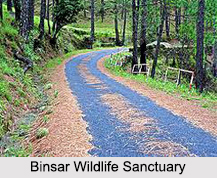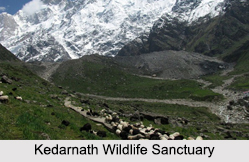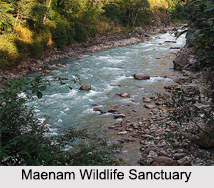 Wildlife sanctuaries of north India are homes to an assortment of flora and fauna. They are protected areas located in the states of Jammu and Kashmir, Uttarakhand, Himachal Pradesh, Haryana, Uttar Pradesh and Punjab. These wildlife sanctuaries provide natural habitat to wild species. Some of the wildlife sanctuaries of north India are described below.
Wildlife sanctuaries of north India are homes to an assortment of flora and fauna. They are protected areas located in the states of Jammu and Kashmir, Uttarakhand, Himachal Pradesh, Haryana, Uttar Pradesh and Punjab. These wildlife sanctuaries provide natural habitat to wild species. Some of the wildlife sanctuaries of north India are described below.
Karakoram Wildlife Sanctuary
Karakoram Wildlife Sanctuary is situated in Leh district of Jammu and Kashmir. It is considered to be one of the few places in India sheltering a migratory population of Tibetan antelope. The wildlife sanctuary has sparse vegetation. About fifteen rare and endangered medicinal plant species have been discovered in the sanctuary.
Askot Musk Deer Sanctuary
Askot Musk Deer Sanctuary is situated at a distance of about 54 km from Pithoragarh in Uttarakhand. Askot is located in the lap of Kumaon Himalayas at a height of about 1,650 meters, with the view of snow capped mountain peaks. The name, Askot has been derived from the word "Asi-kot", that is, 80 forts. Askot was the ancient kingdom of Katyur dynasty. It also has a palace of the last Katyuri king. There are remains of the ancient forts all over the area. The area is rich in sal, oak, pine forest and waterfalls. The area has `Malika Arjun Temple` and `Swami Narayan Ashram`. Askot Sanctuary has charismatic hilly areas and the houses surrounded by greenery. Other inmates of the sanctuary are snow leopards, Himalayan black bears, musk deer, snow cocks, tahrs, bharals, monals, chirs, koklas, pheasants and chukors.
Askot Sanctuary has charismatic hilly areas and the houses surrounded by greenery. Other inmates of the sanctuary are snow leopards, Himalayan black bears, musk deer, snow cocks, tahrs, bharals, monals, chirs, koklas, pheasants and chukors.
Binsar Wildlife Sanctuary
Binsar Wildlife Sanctuary is located at a distance of about 33 km north of Almora town in Uttarakhand. Binsar is famous for its outstanding Himalayan view and wildlife. The splendid view of the Himalayas involves a 300 km stretch of famous peaks, which includes Kedarnath, Chaukhamba, Trisul, Nanda Devi, Nanda Kot and Panchchuli. The sanctuary is one of the most attractive spots in the Kumaon Himalayas and a well-acclaimed hill resort. Binsar Hills is also known as Handy Dear. It offers an excellent view of the Almora town, Kumaon Hills and greater Himalayas. The surroundings prosper in alpine flora, ferns, hanging moss and species of wild flowers. The forests of Himalayan oak and rhododendron are excellent for trekking.
Govind Wildlife Sanctuary
Govind Wildlife Sanctuary is situated in an isolated and complex area of Uttarkashi district in Uttarakhand. It was established in 1955. Part of the sanctuary is above snow line and includes mountains like Swarg Rohini, Black Peak and Banderpoonch. The sanctuary attracts many trekkers and is famous for its greenery. Wide variety of animal species is found here and they include Himalayan black bear, tahr, serow, monal, snow leopard, brown bear, chir, bharal, musk deer, etc. The sanctuary has avifaunal species like koklas, kaleej tragopan, pheasants and chukor.
Kedarnath Wildlife Sanctuary
Kedarnath Wildlife Sanctuary lies in the land of Gods namely, Garhwal in Uttarakhand. It was established in the year 1972 and occupies an area of about 975 square kilometers. In the wasteland of this sanctuary, animals like snow leopard, snow cock, tahr, musk deer, leopard and serow can be seen, along with many species of birds. To study the details of musk deer a project funded by WWF (World Wildlife Fund) was undertaken between 1978 and 1980.
Kibber Wildlife Sanctuary
 Kibber Wildlife Sanctuary is situated on the bank of Spiti River in Himachal Pradesh. It was established in 1992 and spans over a land of about 140050 hectares. The elevation of Kibber Wildlife Sanctuary ranges from about 3,600 to 6,700 m above mean sea level. The vegetation near the sanctuary is sparse and has high medicinal value. The sanctuary is one of the special tourist attractions in Himachal Pradesh.
Kibber Wildlife Sanctuary is situated on the bank of Spiti River in Himachal Pradesh. It was established in 1992 and spans over a land of about 140050 hectares. The elevation of Kibber Wildlife Sanctuary ranges from about 3,600 to 6,700 m above mean sea level. The vegetation near the sanctuary is sparse and has high medicinal value. The sanctuary is one of the special tourist attractions in Himachal Pradesh.
Chhilchhila Wildlife Sanctuary
Chhilchhila Wildlife Sanctuary is located near Kurukshetra University in Kurukshetra district, Haryana. This sanctuary occupies an area of about 28.92 hectares. Dry deciduous type of vegetation is found in the sanctuary. Small and medium-sized woody plants, aquatic plant species and tree species are parts of the flora of the sanctuary. This sanctuary provides shelter to two near endangered species called the oriental darter and the painted stork. Some of the avifaunal species of the sanctuary are gadwall, northern pintail, northern shoveller and common teal.
Katarniaghat Wildlife Sanctuary
Katarniaghat Wildlife Sanctuary is situated in the Terai area of Bahraich district in Uttar Pradesh. It was established in 1976 and covers an area of about 400 square kilometers. It is managed along with the Dudhwa National Park and Kishanpur Wildlife Sanctuary, as parts of the Dudhwa Tiger Reserve under Project Tiger of the Government of India. The forests of Katerniaghat provide strategic connectivity between tiger habitats of Dudhwa and Kishanpur in India and Bardia National Park in Nepal.
Other Wildlife Sanctuaries of North India
Some of the other wildlife sanctuaries of north India are Dachigam Wildlife Sanctuary, Changthang Wildlife Sanctuary, Noorichan Wildlife Sanctuary, Khol Hi-Raitan Wildlife Sanctuary, Bir Gurdialpura Wildlife Sanctuary and Bir Motibagh Wildlife Sanctuary.











